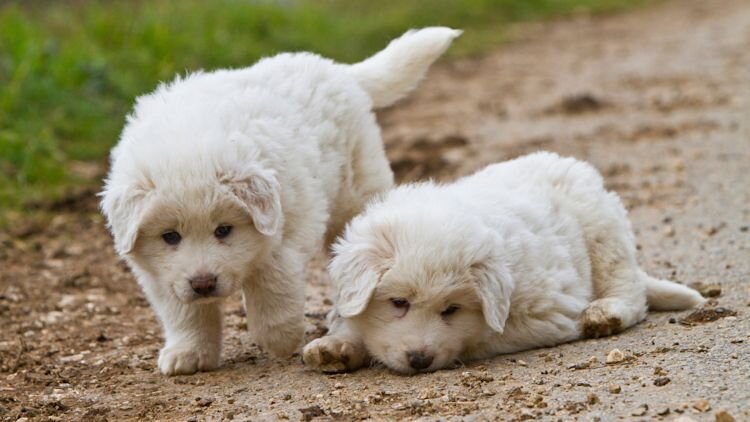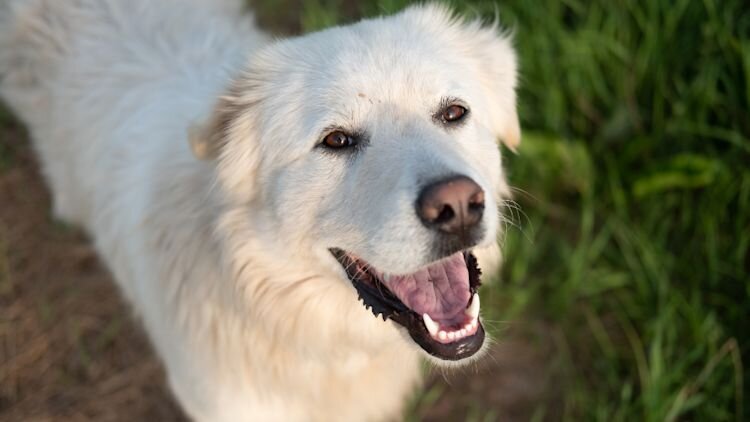Great Pyrenees Growth & Weight Chart: Size Guide by Age
Great Pyrenees — also known as Pyrenean Mountain Dogs or "Pyrs" — are big, beautiful dogs with thick, white coats. The breed gets its name after the snowy Pyrenees mountain range separating the borders of France and Spain, where the dogs were originally bred to protect sheep from predators.
Although the stately size of Great Pyrenees help keep livestock safe, these gentle giants have a calm nature and loving temperament that's made its way into the homes of many pet owners across the world.
If you're welcoming a Pyr puppy into your family, you may be wondering, How big do Great Pyrenees get? Members of this breed will require a significant amount of space, so to help you plan, we created a Great Pyrenees growth chart broken down by weight and age. Use it to track stages of development to ensure your pup gets a healthy start in life.
Table of Contents:
Great Pyrenees Growth Chart By Age & Weight
Age | Male Weight | Female Weight |
|---|---|---|
1 mo | 5 - 10 lb | 5 - 10 lb |
2 mo | 15 - 30 lb | 10 - 25 lb |
3 mo | 30 - 40 lb | 25 - 35 lb |
4 mo | 45 - 55 lb | 35 - 45 lb |
5 mo | 60 - 70 lb | 45 - 55 lb |
6 mo | 70 - 80 lb | 50 - 60 lb |
7 mo | 75 - 85 lb | 55 - 65 lb |
8 mo | 80 - 90 lb | 60 - 70 lb |
9 mo | 85 - 95 lb | 65 - 75 lb |
10 mo | 90 - 100 lb | 70 - 85 lb |
11 mo | 95 - 105 lb | 70 - 90 lb |
12 mo | 100 - 115 lb | 80 - 95 lb |
24 mo | 100 - 125 lb | 85 - 100 lb |
If your puppy is ahead or behind the numbers above, don’t worry too much! Our Great Pyrenees size guide is made up of estimates based on the average weight by age. Continue taking your pet to regular vet visits and discuss any concerns you may have about your Great Pyrenees’ size or growth rate.
Pro Tip: Give yourself a financial safety net for veterinary bills when you sign up for a dog insurance plan. Many plans will reimburse you for up to 100% of out-of-pocket veterinary costs. Compare Great Pyrenees health insurance options today.
How big do Great Pyrenees get?
According to the American Kennel Club (AKC) Official Breed Standards1, the size of a male Great Pyrenees weighs over 100 pounds and stands 27 to 32 inches in height from the ground to the top of the shoulders. Comparatively, the female Great Pyrenees is smaller in size, weighing over 85 pounds and standing between 25 and 29 inches tall.
According to the AKC, a mature Pyrenean Mountain Dog should have a muscular build beneath its thick coat, with a short, strong neck, moderately deep chest, and a long tail that hangs low to the ground. Dogs of this breed are characterized by an elegant gait and majestic appearance.

How big are Great Pyrenees at six months old?
At six months, a male Great Pyrenees will weigh approximately 70 to 80 pounds. In contrast, a six-month-old female Great Pyrenees will weigh less, between 50 to 60 pounds. Both males and females will have a significant amount of growing left to do before they reach their adult size.
Pro Tip: Use our Great Pyrenees growth chart to monitor your pet’s size progression, and don’t forget to download our new puppy checklist to ensure they have everything they need to develop at a healthy rate.
When do Great Pyrenees stop growing?
As a giant breed, Great Pyrenees growth stages are slower and require more time than most dogs to reach their mature size. You can expect your puppy to be close to full size around their first birthday, but most Great Pyrenees puppies will need up to two years to fully mature and fill out their chest2.
How much more will my Great Pyrenees puppy grow?
There are three ways to predict the size of a Great Pyrenees at maturity:
- Age. You can estimate where your puppy is in the Great Pyrenees growth stage based on how old they are. Most Pyrs will need up to 24 months to reach their adult size, so if they are less than two years old, you can expect them to continue growing.
- Genetics. Most puppies do not grow to be larger than their biggest parent. If you purchased your Great Pyrenees pup through a breeder, contact them for more information about your puppy’s expected size based on their parents and how large past litters grew to be.
- Paw Size. Lastly, you can take a look at your puppy’s paws. Oversized paws are a classic puppy feature, indicating that your puppy is still growing.
How do I make sure my Great Pyrenees is healthy?
Our Great Pyrenees puppies are cherished members of our family, and they deserve the best. One of the best ways to help your Great Pyrenees live a happy and fulfilling life is through excellent, gold-standard veterinary care, which can help your pup minimize or avoid health problems in the future.
As is the case with all purebred dog breeds, Great Pyrenees are more prone to certain genetic diseases and conditions. In particular, Great Pyrenees are more susceptible to hip dysplasia, bone inflammation, and osteosarcoma3. Preventative veterinary care can screen for diseases that your Great Pyrenees is more vulnerable to, which can help your veterinarian find diseases earlier, which often helps your dog’s overall prognosis.

Great Pyrenees Veterinary Costs
Pet parents need to be aware that vet visit costs can be very expensive to treat Great Pyrenees dogs, especially for emergency or chronic care. This is because any medical procedure they undergo or medicine they’re sent home with will be based on the Great Pyrenees’ weight, so costs are automatically three to four times higher than for small dogs.
For example, the Great Pyrenees breed is more prone to osteosarcoma, an aggressive type of bone cancer that requires ongoing management. Treatment can cost several thousand dollars, with some cases adding up to more than $10,000, depending on the amount of chemotherapy and procedures required4.
When surveyed, less than 20% of pet owners said they would be able to afford a $5,000 veterinary expense out-of-pocket, which could leave many potential pet owners in a scary situation if their beloved pet becomes ill or has an accident. Pet insurance helps offset this financial risk by reimbursing up to 100% covered veterinary costs, allowing you and your vet to focus on what’s truly important: your dog’s health and happiness.
Key Takeaways
- According to the American Kennel Club, Male Great Pyrenees should weigh over 100 pounds and stand between 27 to 32 inches tall.
- Female Great Pyrenees should weigh over 85 pounds and stand between 25 and 29 inches tall.
- Great Pyrenees are more prone to certain diseases, such as osteosarcoma and hip dysplasia.
- Pet insurance provides you with a financial safety net for diseases or conditions your puppy develops.
References
- American Kennel Club, “Great Pyrenees” Accessed Aug. 24, 2021.
- Pet Educate, "When Is A Great Pyrenees Fully Grown?" Accessed Aug. 24, 2021.
- Vet Care Animal Hospital, “Great Pyrenees” Accessed Aug. 24, 2021.
- Veterinary Centers of America, “Osteosarcoma in Dogs” Accessed Aug. 24, 2021.
Do you want to find the best pet insurance?
Let's analyze your pet's breed, age, and location to find the right coverage and the best savings. Ready?
Analyze My PetAbout Pawlicy Advisor
The pet insurance marketplace endorsed by veterinarians, at Pawlicy Advisor we make buying the best pet insurance easier. By comparing personalized coverage and pricing differences we can save you a ton of money, up to 83% in some instances!
Instantly Compare Pet Insurance Plans
Guides
Determine If Pet Insurance Is Worth It
Comparison Charts
Find Your State
Dog Insurance
Small Animal Relief Veterinarian
Lila Batiari, DVM is a relief veterinarian located in San Diego, California. She has a special interest in nutrition, pain management, and surgery! Dr. Batiari enjoys working with Pawlicy Advisor to help others avoid everyday situations that some of her clientele experience. She realizes that expensive vet bills for treatment costs could be much easier for patients with pet insurance.
